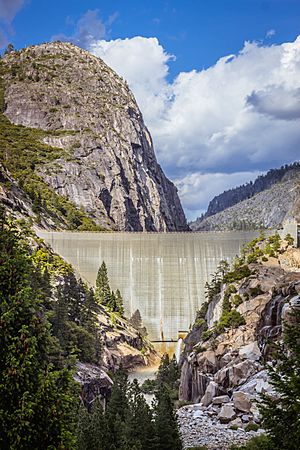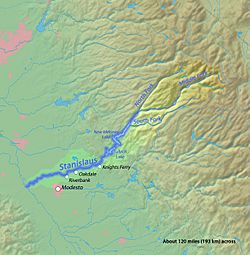Donnells Dam facts for kids
Quick facts for kids Donnells Dam |
|
|---|---|
 |
|
|
Location in California
|
|
| Official name | Donnells 62-005 Dam |
| Country | United States |
| Location | Tuolumne County, California |
| Coordinates | 38°19′48″N 119°57′46″W / 38.33000°N 119.96278°W |
| Opening date | 1958 |
| Owner(s) | Tri-Dam Project |
| Dam and spillways | |
| Type of dam | Concrete arch |
| Impounds | Middle Fork, Stanislaus River |
| Height | 291 feet (89 m) |
| Length | 714 feet (218 m) |
| Elevation at crest | 4,921.8 feet (1,500.2 m) |
| Reservoir | |
| Creates | Donnell Lake |
| Total capacity | 56,893 acre-feet (70,176,000 m3) |
| Catchment area | 229 square miles (590 km2) |
| Surface area | 401 acres (162 ha) |
| Power station | |
| Installed capacity | 72 MW |
| Annual generation | 270,234,000 KWh (2001–2012) |
Donnells Dam is a large concrete arch dam located in Tuolumne County, California. It sits on the Middle Fork of the Stanislaus River. The water held back by this 291-foot (89 m) tall dam creates Donnell Lake within the Stanislaus National Forest.
The dam and the lake are owned by two groups: the Oakdale Irrigation District and the South San Joaquin Irrigation District. Donnells Dam is one of three dams that make up the Tri-Dam Project. The other two dams in this project are Beardsley Dam and Tulloch Dam.
Donnells Dam is 750 feet (230 m) long at its top. Donnell Lake can hold a lot of water, about 56,893 acre-feet. This water, along with water from the other Tri-Dam Project reservoirs, helps water about 117,500 acres of farmland. This farmland is located in Stanislaus and San Joaquin counties. The dam also helps make electricity and provides water for cities.
How Donnells Dam Was Built
In the late 1930s, the Oakdale Irrigation District (OID) and South San Joaquin Irrigation District (SSJID) realized they needed more water. Their old water systems were not big enough for the growing demand. So, they decided to work together to create the Tri-Dam Project.
On January 13, 1948, they announced their plan. It included building new dams, reservoirs (lakes), and power plants. These would be at the locations of what are now Beardsley, Tulloch, and Donnell reservoirs. They also planned to improve their older water systems.
For the next eight years, the districts faced many challenges. They had money problems and arguments over who had the right to use the land. For example, another water district already had a claim for the Donnells site. In 1953, they finally settled these arguments over water rights. As part of the deal, Donnells and Beardsley reservoirs would mainly be used to make power. Water would only be released if it was needed downstream.
After solving the land and water rights issues, they needed to find money. They decided to sell bonds. Bonds are like loans that people or companies buy from a government or organization. The organization promises to pay them back later with interest. With help from Pacific Gas and Electric Company (PG&E), they successfully sold these bonds.
Construction of the dams began in 1955. To pay back the bonds, the districts made a deal with PG&E. They sold the electricity made by the dams' power plants to PG&E for fifty years. This agreement ended in 2004.
What Donnells Dam Is Used For
Donnells Dam is very important for making electricity. It works with the other two dams in the Tri-Dam Project to produce a lot of power.
The dam is also in a beautiful area with steep, rocky canyons. This makes it a great place for outdoor activities. People can enjoy fishing, hunting, boating, camping, and hiking around Donnell Lake.




